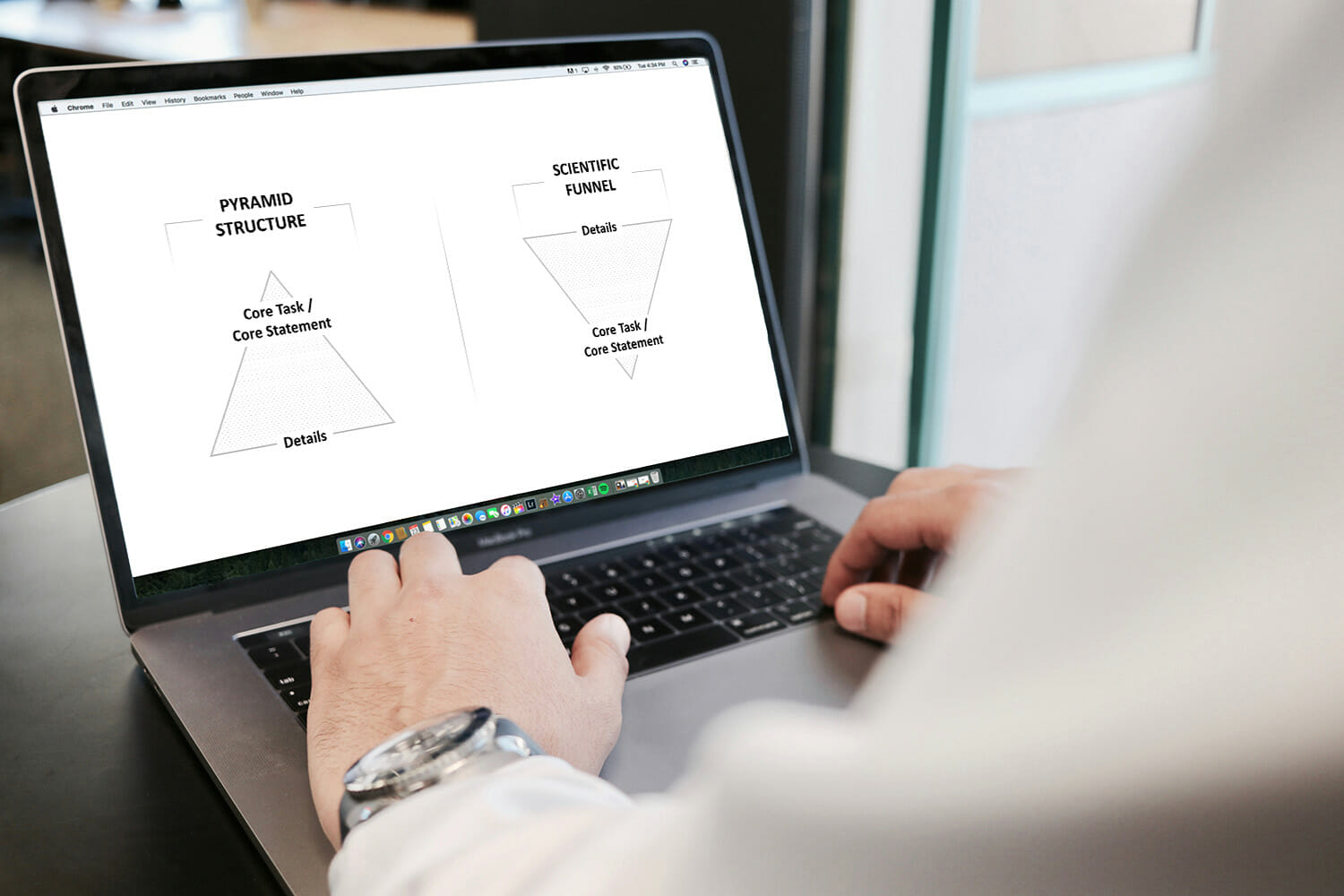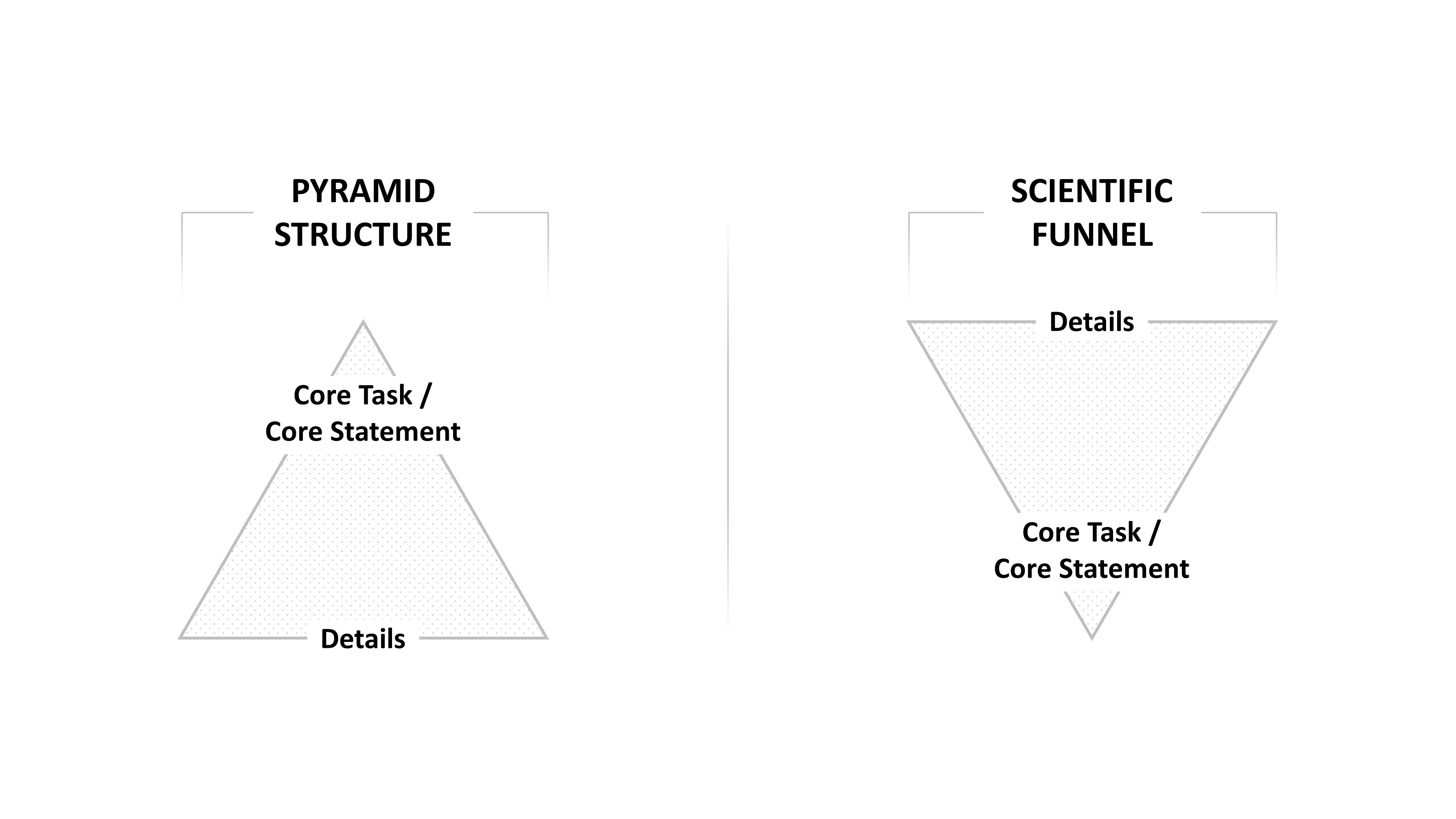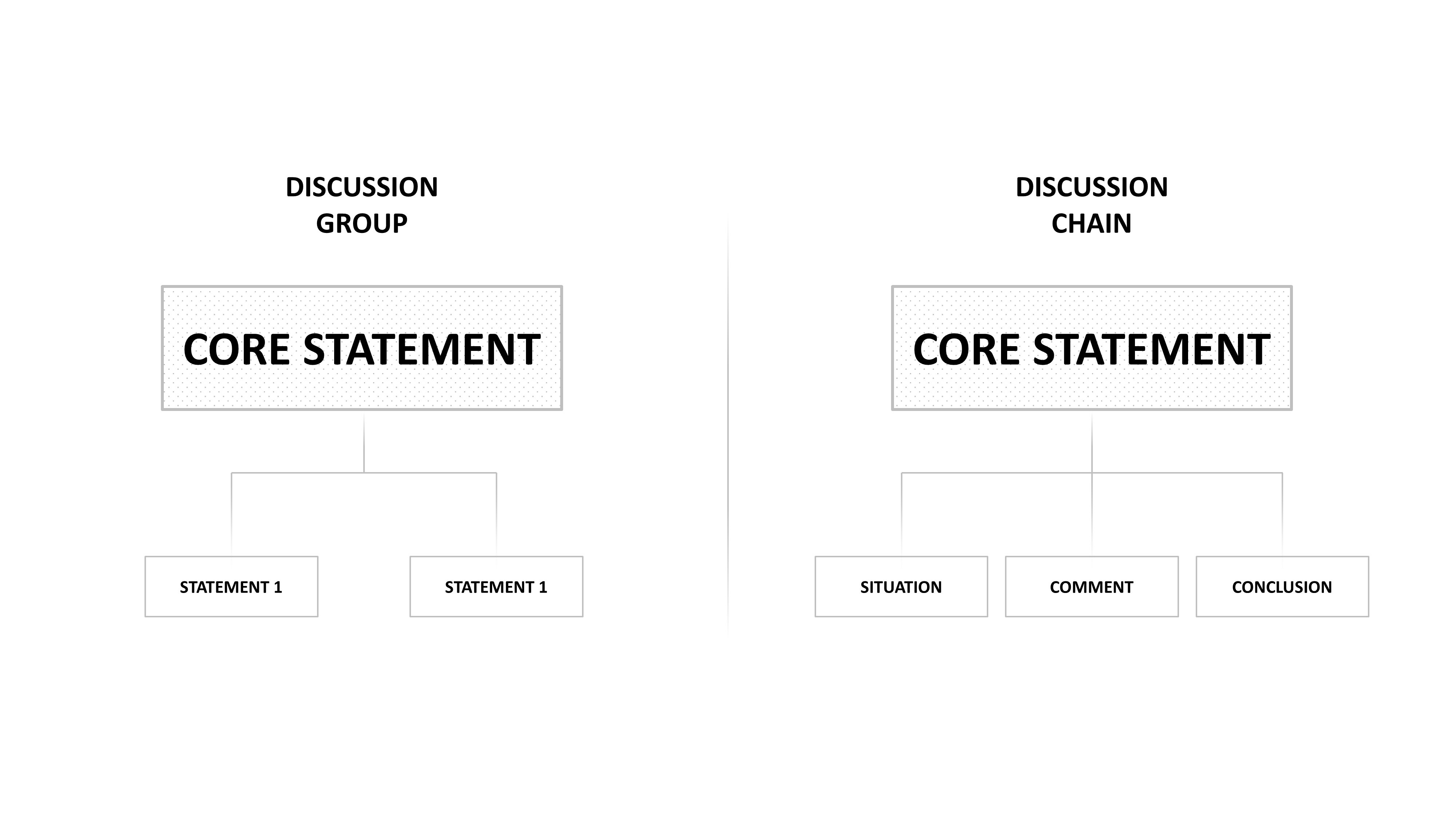
Present Better with the Pyramid Principle
Presentations are part of everyday business life and often provide the impetus for reaching important decisions and agreements. In scientific presentations, the process is often more important than the result itself, which is why facts and processes are first presented in detail.
The outcome is then given in the final paragraph. This approach to presenting is a bit like a funnel – the bulk of the information is given right off the bat and then tapers off as the presentation progresses. But this can often overwhelm the listener, especially when time is at a premium.
Barbara Minto, a former employee at McKinsey, saw the need to streamline executive communication and logically structure arguments. She developed the then novel approach of the Pyramid Principle.
Who is Barbara Minto?
Barbara Minto grew up in Cleveland, Ohio and was one of the first women to attend Harvard Business School from 1961-1963, where she received an MBA. In the 1970s, she was employed as a consultant with McKinsey & Company, one of the world’s most renowned management consultancy firms.
In 1966, she moved to the London McKinsey office to pass on her knowledge to European consultants. Barbara Minto has lived in London since 1973 and has since then worked with her company (Minto International Inc.) as a consultant for leading international companies.
She wrote her book, The Pyramid Principle, in which she describes how to communicate ideas clearly, intelligibly and successfully.
The Pyramid Principle: What is it?
The pyramid principle: Create clear, understandable and successful presentations.
If storytelling is “too playful” for you, you should structure your presentation according to the pyramid principle of Barbara Minto (McKinsey). The basic idea: inform quickly about your findings. This saves time and gets to the heart of your presentation quickly.
With the Pyramid principle, the core statement is given directly at the beginning of the presentation. This is followed by supporting arguments and finally, any data that supports the arguments. This provides a solid foundation to substantiate the core statement.
Minto’s principle is not only used for talks and presentations, but can also be integrated into personal communication, such as emails and reports.
Why the Pyramid Principle is so important for presentations
In today’s fast-moving times, results and receiver-focused communication is particularly important. Perhaps you have experienced yourself getting bored or missing the point during a presentation. Another example would be a project manager who presents how a project was successfully executed by describing all
steps chronologically and in great detail. He or she runs the risk of completely losing their audience; they may even leave early. “You could have said that right away!” or “Now I finally understand what you meant.” can be heard from the audience. With the Pyramid Principle, you get right to the point.
Many company presentations are often a string of slides with a wide variety of statements. Often there is no didactic structure that informs, is integrated into a story and is convincing at the end. But a successful, customer-oriented presentation needs a clear structure that leads and guides the audience from the introduction to the main part to the conclusion. Use the pyramid presentation here!
You can find many more helpful tips on how to keep the audience’s attention in the article “7 useful tips on how to control the audience’s attention”.
The focus should be on the outcome
The information overload of recent years has brought about a major change in the requirements for professional communication. Information overkill and a lack of clarity are central challenges. All the more reason for professionals to present their results succinctly and clearly. Time constraints also play a major factor these days. Most managers prefer a results-oriented presentation.
This can even be seen in email. Overflowing inboxes make it almost impossible for us to follow and absorb long messages. Most people focus only on the subject and check the first lines for relevance. If the direct reference is opaque, people usually don’t have the patience to read the email through and can’ t react to the core statement at the end.
The Pyramid Principle solves this problem. Instead of having to build a bridge between the unimportant and the essential, the core message opens the presentation or email.
Example:
Core statement: We want to focus our marketing strategy on social media.
Argument: We must grow and hire new employees.
Challenge: It’s not easy for our company to attract young employees and retain them..
Solution: We’re launching a new HR marketing campaign (description).

Impress with a clear structure
The key statement is right at the top of the pyramid. On the second level are the main arguments.
The base, which becomes broader towards the bottom, is formed by supporting arguments and data. This pyramid structure can be theoretically extended at the bottom as required.

How should the core message be framed?
This is the central, essential message of the topic. As the top of the pyramid, this message is the essence of the entire presentation. The core statement can also serve as an answer to the listener’s question.
Important: Our short-term memory’s ability to process and store information is limited.
What are the advantages of the Pyramid Principle?
- The information presented can be better absorbed.
- The listeners can assess whether each detail supports the core message or not.
- The clear structure makes it easier to organize and remember the information.
Communication starts with the expectations of the recipient.
- It satisfies the central need for information right at the beginning, when attention is at its peak.
- It saves time when writing documents.
- It makes it easier to “see” the connections between different points.
Capitalize on the pyramid’s effectiveness
As a presenter, you want to lead your audience from beginning to end with focus and purpose. organizing your content using the “funnel” approach makes that difficult. Following your content becomes tedious, maybe even uninteresting. When you put the core message at the end, the listener is also faced with the almost insurmountable challenge of having to recall all the details they have already heard.
Presenting your core message right off the top piques the audience’s curiosity; they can’t help but engage with your assertion.
Example:
In your presentation, you state that you and your company are investing in a conservation project and would like to improve the corporate image.
You then explain your key statements with four arguments:
- Practical solution
- Procedure
- Resources
- Time organization
You can also divide these key statements into supporting statements and optimize your structure with correlating factors.
Important tips to keep in mind when using the Pyramid Principle:
1) Don’t use complete sentences on your slides
Avoid using full sentences whenever possible. Instead, use short and concise phrases, much like in a telegram. This gives you the freedom to speak directly to your audience and bring your presentation to life with facial expressions and gestures.
One exception is headings, which are best written out. The advantage of this is that that you can use your headings to get back on track if you find you’ve strayed off topic. it also helps the audience follow the presentation.
2) Explain only one idea or group of ideas on one slide
Break down a complex issue into more manageable sections. This allows you and your listeners to concentrate on one thing at a time.
3) Stay focused, consistent and precise
When making a presentation, keep it as focused as possible. Think about the goal you want to achieve and align your content accordingly. Stay consistent and free of contradictions in your presentation. With the right preparation, you have a much better chance of getting through your presentation smoothly and successfully.
4) Design your presentation slides and handouts differently
It is not always easy, but if you can, avoid using extensive data and too much continuous text in your presentation. As already mentioned above, slides should be written in a shorthand style. Underline your statements with clear and expressive graphics.
Here too, the motto is, “Less is more”. Avoid bright colors and too many fonts. The handout, on the other hand, can be a little more detailed. Formulate entire sentences and enhance your statements with figures and tables.
5) Present concisely and purposefully
As they say, time is money. Keep your presentation as short as possible without stuffing too much information into it. The more relaxed you appear, the more relaxed your audience will be. As a rule, most business presentations take between ten and 45 minutes.
If you think your message will take longer than 45 minutes to get across, it might be an indication that your message hasn’t been clearly defined or that you’ re focusing on too many details. Remember, you don’t need to explain everything to your audience.
6) Involve your audience
No matter how long the presentation is, monologues are never interesting. Interact with your audience. Get them involved by asking questions or start a brainstorming session to find a solution to a problem.
7) Don’t forget to transition
You already know what you’ re going to say next — your audience doesn’t. Organize your slides to build suspense and keep your audience engaged. Segue into the next slide. For example, you could say “Having analyzed the price development, we’ll now look at the projected results”.
8) A satisfying conclusion
Use the end of your presentation to give your audience a clear overview of what has already been achieved and the next steps. Your audience will leave the room with a positive feeling.
Conclusion: The Pyramidal Principle cannot always be applied to presentations
The communication concept developed in 1991 is now part of the standard training of many consulting firms. The phrase “To make it Minto” has already become established in some corporate cultures. However, it cannot be applied to all presentations.
If you have to reckon with the rejection of a large part of your audience from the outset, you should not put the core statement at the beginning. By doing so, you run the risk that your audience will no longer be open to the following supporting arguments. Therefore, depending on the topic and the target group, you should reconsider whether you prefer to proceed according to the pyramid or the funnel principle.
There is no one-size-fits-all solution and the more practised and experienced you become in preparing your presentations, the easier it will be for you to decide. The size of your pyramid also depends on the topic, the target group and your time. For example, in a short keynote presentation, you will naturally not have the opportunity to go into great depth and expand on your details. Pyramidal presenting is also not recommended in the context of a course.
If you explain the end result right at the beginning, the topic can no longer develop and be elaborated in individual steps up to the solution. The same applies to emotionally charged presentations. Here, too, the end result should not be placed at the beginning of the presentation, otherwise it will not be effective.
Do you have any questions about the 10 secrets for a perfect presentation or about PowerPoint in general? Don’t hesitate to contact us at [email protected]. We will be happy to help you!
Are you looking for visually supportive and professionally designed slide templates? Take a look around in our shop. Here we have numerous prepared slides for you to download on a wide variety of (business) topics. Take a look today! To the shop




